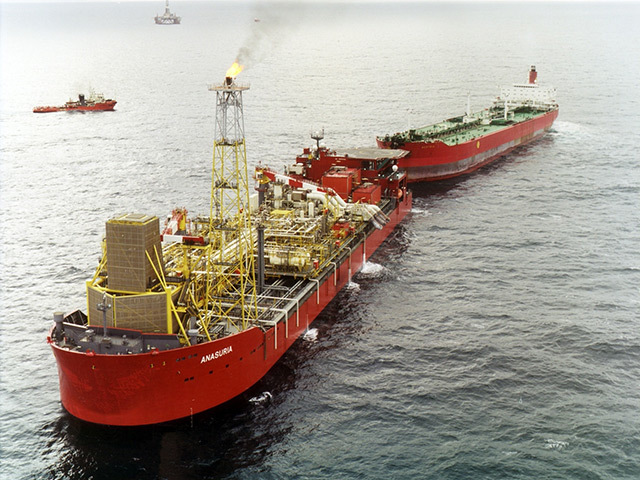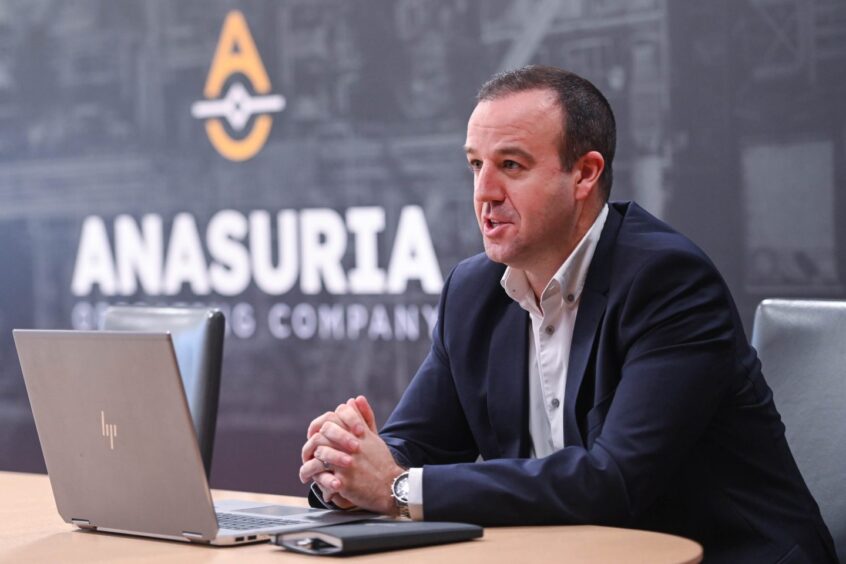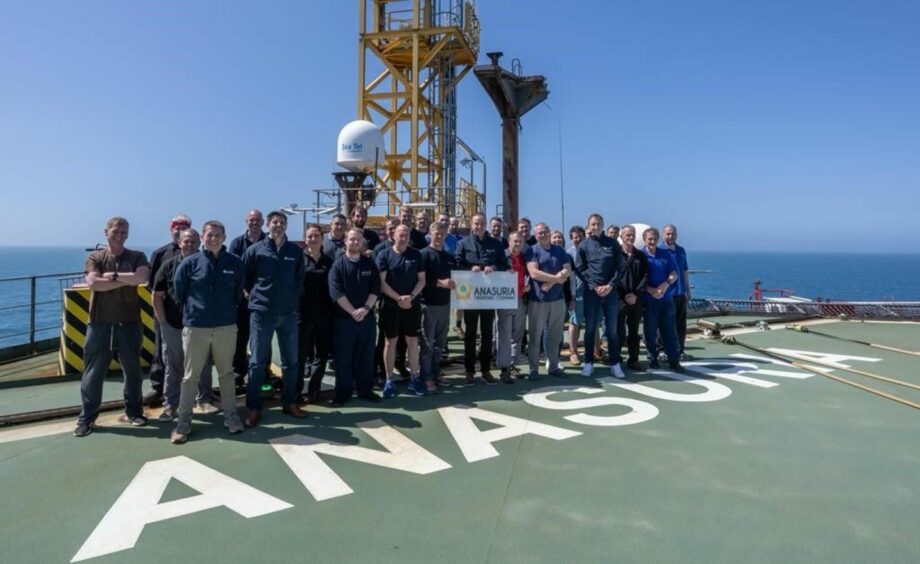
Anasuria Operating Company (AOC) has plenty of reasons to celebrate this festive season after an “exciting” first year as a North Sea duty holder.
Set up as a joint venture between Malaysian firms Hibiscus Petroleum and Ping Petroleum in 2015, AOC took over operatorship of the Anasuria Cluster from Shell the following year.
Located approximately 108 miles east of Aberdeen, its namesake Anasuria floating production storage and offloading (FPSO) vessel produces several fields including Teal, Teal South, Guillemot and Cook.
AOC initially handed the reins to Petrofac in 2016, but last year in June the company took over the operating duties for the FPSO and associated pipelines.
At the time of the handover, AOC chief executive Richard Beattie said it was an “important milestone” and a “natural progression” in its journey towards becoming a “best-in-class operating company”.
Speaking to Energy Voice at AOC’s new offices in Rubislaw, Mr Beattie said while 2023 had been an exciting year for the “transformation” of the company, it has also been a very busy one.
Completing assurance undertakings and numerous safety inspections had been a “big commitment” for the company, but taking ownership of “key aspects” of the business had allowed AOC to make changes to its structure and greater ownership of its contracts.
“Taking a number of things in-house and having more autonomy over those has allowed us to make a faster pace of change than we were previously seeing,” Mr Beattie said.
New AOC brand identity
Evidence of the recent changes at AOC over the past year has been relatively easy to see in a visual sense.
Since taking command of the FPSO in 2022, AOC has rolled out a new look brand and in August the company marked one year since moving into its new headquarters in the H1 Hill of Rubislaw complex in Aberdeen.
“We spent a lot of time over that last 12 months embedding the new values, the vision, the mission and other things like the branding and getting everyone looking the same offshore in terms of kit,” he said.
“It’s little things like that that make a difference.”
While the immediate visual change in the company has been significant, Mr Beattie said efforts to implement cultural changes within the organisation were more about enhancing what was already there.
“Anasuria was good anyway, it’s not like it had a bad culture. Often with changes and when new companies come in, they try and maybe change the culture,” he said.
“I’m not trying to change the culture of Anasuria, because it was good, what we inherited was good.
“But what we’ve really tried to do is just continue that and help and enhance it where we can.”
But in making these changes, AOC did not want to disrupt what was already a well-functioning asset.
“On day one I said to the guys on the asset, ‘When you switch on your PC day one, you should really notice very little difference’,” Mr Beattie said.
“We wanted to be business as usual as much as possible, but I said [at the beginning] that the change is coming and the cultural changes that we’ve made, the whole soul of the company will feel a significant change.”
2023 ‘best year operationally’ for AOC
While 2023 has been a year of significant change for AOC, it has also been a year of high performance.
“It’s been an exciting first year and I think it’s also coinciding with the best year that we’ve had operationally as well,” Mr Beattie said.
“We’ve had extremely good uptime with good safety performance in the year.”
Achieving these results had not been without its challenges though, in a testing year for the North Sea as operators across the region grappled with supply chain pressures coupled with the windfall tax.
Supply chain pressures for Anasuria
Many of the challenges faced by AOC management this year are ones made more difficult by the company’s position as a single asset operator, Mr Beattie said.
“Anasuria as a single asset is, maybe not quite unique to the North Sea, but there’s not many single asset companies who are operator/duty holder,” he said.
The war in Ukraine and subsequent inflationary pressures had led to several supply chain challenges for AOC, particularly in relation to its helicopter logistics.
“We only have one asset and a few flights, so we don’t have a big airframe piece on there so that’s a challenge for sure,” Mr Beattie said.
“We’ve definitely seen that as a business challenge to try and maintain the helicopters that we require for the business which we’ve been successful at, we haven’t had any business interruption to it, but it has been commercially challenging across the industry.”
EPL makes North Sea investments ‘marginal’
Like many other operators in the North Sea, the introduction of the UK government’s Energy Profits Levy (EPL) had also caused headaches at the firm.
“The biggest challenge that we have is around, no shock, the EPL and the fiscal changes that have come in,” Mr Beattie said.
“We have Malaysian owners, Ping and Hibiscus, and they both have other opportunities outside of the UK to invest in and we, along with other operators, are seeing that same challenge.
“It does make investments in the North Sea marginal.”
The structure of the windfall tax had placed a greater burden on smaller companies like AOC, Mr Beattie said.
“This one-size-fits-all across the industry approach, when you have a lower profit margin anyway such as Anasuria, chipping into that obviously makes it extremely challenging,” he said.
While presenting challenges, the EPL had also provided financial incentives to invest in the Anasuria FPSO.
“It’s not expected to change until 2028, so there is an incentive for investing,” Mr Beattie said.
“Anasuria has some asset life extension work that we’re doing anyway and so we’re looking at how can we optimise the investment as well as investing in the asset at the same time.”
Fyne and Teal West
Looking ahead to future opportunities, Mr Beattie said AOC is continuing to explore operating the Anasuria FPSO as a hub for third-party tiebacks in the region, a primary goal of his since taking on the leadership of the company four years ago.
“Because Anasuria does still have a lot of reserves in the ground and we’re managing at a high uptime, and we believe that it’s a very good option for a hub type strategy,” he said.
Opportunities surrounding the Fyne and Teal West fields have been critical for AOC, Mr Beattie said.
“From Anasuria’s perspective we’re keen to attract third parties back,” Mr Beattie said.
“That’s been part of our strategy, to demonstrate that an older asset can have extremely high uptime and can be run efficiently, not just from an uptime perspective but also from a cost perspective.
“There are a lot of reserves in and around our asset in the North Sea that are kind of stranded and need somewhere to come back to, so Fyne is a really positive announcement for Anasuria.”
With Hibiscus receiving regulatory approval for its Teal West tieback plans in August, Mr Beattie said it further demonstrated the viability of Anasuria as a hub.
“There’s a lot of investment associated with these tie-backs. They require wells, they require infrastructure to come back in,” Mr Beattie said.
“You could say it’s too difficult to invest, but I think we demonstrate there is still value there.”
Mr Beattie said in terms of production, the tiebacks represent a significant increase for Anasuria.
“If you look at the size of the operating company that we are, I have about 40 people in [this office] and we’re supporting about seven and a bit thousand barrels of oil equivalent per day on the asset,” he said.
Anasuria electrification
As the operator of an older FPSO asset, AOC is also conscious of looming challenges surrounding upcoming emissions requirements imposed by the North Sea Transition Authority (NSTA).
Mr Beattie said while the company is open to the idea of electrification, there are barriers to implementing this for the Anasuria vessel.
“For Anasuria, there are challenges around the actual makeup of the asset in terms of the turret and there are challenges to be overcome in terms of electrification to the FPSO within the type of structure that we have,” he said.
“However, for me those are challenges and they’re not necessarily blockers.”
Central to the question of electrification for any asset is where the electricity is sourced from, Mr Beattie said.
“If we needed to modify the asset to accept the electricity and to take it through, the challenge I would see is where’s it going to come from,” he said.
“From an engineering perspective you can overcome almost anything with time, resource and money.
“So you’d have to evaluate, ‘Is it worthwhile? Can you do it?’. That’s the challenge in terms of the timing.”
Mr Beattie said under its current plans, AOC is hoping to continue operating the Anasuria FPSO until at least 2035, and hopefully longer if possible.
When asked if he was concerned by the challenges posed in reducing emissions at the FPSO, Mr Beattie said his job was to try and address the challenge and evaluate what can be done.
“If there’s a better way to run the asset, if there’s a more efficient way that you can run the asset, less intensive CO2 measures or anything like that then we will. We’re open to it,” he said.
“We’re not set in our ways saying, ‘No, this is the only way that we can do it and it’s an old asset’.”
Continued investment for Anasuria
Over the next 12 months, Mr Beattie said asset life extension of the Anasuria will continue to be a priority for AOC as parts of the vessel near the end of their design life.
“Anasuria is now 27 years old, there are parts of it in terms of asset life extension that we need to address,” he said.
In the last few years the company has changed out risers, the ship side valve, and three of the top sections of its mooring chains in what was a “major campaign”.
“There’s going to be a period of adapting and adjusting and investing in the asset to ensure we can go out to 2035,”
But while the Anasuria is not without its challenges as an ageing vessel, Mr Beattie said AOC was not yet considering decommissioning plans.
“We look at 2035 in terms of, we still have a viable business up to that point, and we’re still economic at that point,” he said.
“We are not in the point of decommissioning on the asset at all, if anything we’re investing in the asset.
“We’re very much still moving in through an investment phase as I see it on Anasuria over the next few years, which is really exciting.
AOC looking ahead
Looking ahead to the next 12 months and AOC’s second year as a duty holder and operator, Mr Beattie said the company will look to continue its success achieved from investment in the asset.
“We’ve taken over an asset and we’ve lowered and managed the cost, but we’ve managed to increase the uptime and the efficiency quite significantly on the asset,” he said.
“There are multiple ways you can do that; you need to invest but you have to invest in the right places.”
For AOC, that meant investing in its most important asset; its people.
“We’re really lucky on Anasuria in terms of the people and the crew. We’ve got a really strong crew on Anasuria, a lot of people who have been lifers on Anasuria,” he said.
“They’ve been with it since the yard and they’re still with the asset. The culture on Anasuria is very strong, very loyal to the asset.
“And I know people like to say, ‘People are the most important thing’. But for me, genuinely the piece I would like to get across from Anasuria is, yes we’ve invested in the asset, yes we’ve spent money on it, yes we’re continuing to invest.
“But what we’ve really invested in is the people and the welfare and the engagement.”
Recommended for you



 © Supplied by Image: Darrell Benns
© Supplied by Image: Darrell Benns © Supplied by Image: Darrell Benns
© Supplied by Image: Darrell Benns © Supplied by Anasuria Operating C
© Supplied by Anasuria Operating C